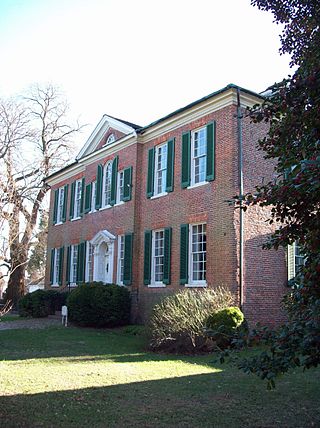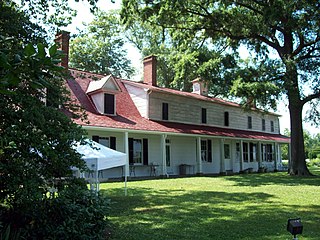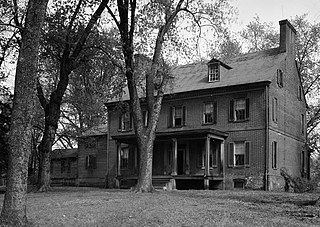
Darnall's Chance, also known as Buck House, Buck-Wardrop House, or James Wardrop House, is a historic home located at 14800 Governor Oden Bowie Drive, in Upper Marlboro, Prince George's County, Maryland, United States.

The William Paca House is an 18th-century Georgian mansion in Annapolis, Maryland, United States. Founding Father William Paca was a signatory of the Declaration of Independence and a three-term Governor of Maryland. The house was built between 1763 and 1765 and its architecture was largely designed by Paca himself. The 2-acre (8,100 m2) walled garden, which includes a two-story summer house, has been restored to its original state.

His Lordship's Kindness, also known as Poplar Hill, is a historic plantation estate on Woodyard Road east of Clinton, Maryland. It was built in the 1780s for Prince George's County planter Robert Darnall. The five-part Georgian mansion retains a number of subsidiary buildings including a slave's hospital and a dovecote. The property is now operated as a museum by a local nonprofit preservation group. It was designated a National Historic Landmark in 1970.

Riversdale, is a five-part, large-scale late Georgian mansion with superior Federal interior, built between 1801 and 1807. Also known as Baltimore House, Calvert Mansion or Riversdale Mansion, it is located at 4811 Riverdale Road in Riverdale Park, Maryland, and is open to the public as a museum.

Sion Hill is a National Historic Landmark in Havre de Grace, Maryland, notable as an example of high-style Federal architecture and as the home of a family of prominent officers of the United States Navy.

Sotterley Plantation is a historic landmark plantation house located at 44300 Sotterley Lane in Hollywood, St. Mary's County, Maryland, USA. It is a long 1+1⁄2-story, nine-bay frame building, covered with wide, beaded clapboard siding and wood shingle roof, overlooking the Patuxent River. Also on the property are a sawn-log slave quarters of c. 1830, an 18th-century brick warehouse, and an early-19th-century brick meat house. Farm buildings include an early-19th-century corn crib and an array of barns and work buildings from the early 20th century. Opened to the public in 1961, it was once the home of George Plater (1735–1792), the sixth Governor of Maryland, and Herbert L. Satterlee (1863–1947), a New York business lawyer and son-in-law of J.P. Morgan.

Snow Hill is a manor house located south of Laurel, Maryland, off Maryland Route 197, in Prince George's County. Built between 1799 and 1801, the 1+1⁄2-story brick house is rectangular, with a gambrel roof, interior end chimneys, and shed dormers. It has a center entrance with transom and a small gabled porch. A central hall plan was used, with elaborate interior and corner cupboards. The original south wing was removed and rebuilt, and the home restored in 1940. The Late Georgian style house was the home of Samuel Snowden, part owner of extensive family ironworks, inherited from his father Richard Snowden. and is now owned and operated by the Maryland-National Capital Park and Planning Commission as a rental facility.

The George Washington House, or Indian Queen Tavern, is located at Baltimore Avenue, at Upshur Street, in Bladensburg, Prince George's County, Maryland. It was constructed in the 1760s. The 2+1⁄2-story structure is constructed of brick Flemish bond on ends. The plan is rectangular, with a gabled roof, exterior end chimneys, gabled shingled dormers. There are first and second-story center entrances, each with a transom. There is a full-width one-story porch with balustraded deck and side entrances. The structure includes a later two-story rear addition. The structure is Georgian.

Bostwick is a historic home located a short distance below Lowndes Hill, the present-day property of Bladensburg Elementary School in Bladensburg, Prince George's County, Maryland, United States. According to its date plaque, it was built in 1746 by Christopher Lowndes (1713-1785). The house was later the home of Lowndes’ son-in-law, Benjamin Stoddert (1751-1813), first Secretary of the Navy. Colonel Thomas H. Barclay resided at "Bostwick," the oldest surviving structure at Bladensburg. Located nearby is the Market Master's House, also built by Lowndes.

Abraham Hall, constructed in 1889, is located on the northeast side of Old Muirkirk Road in the center of the historic African American community of Rossville, a section of Prince George's County, Maryland near Beltsville.

Beall's Pleasure is a historic home located in Landover, Prince George's County, Maryland, United States. The original owner of the land was Colonel Ninian Beall. He helped establish the first Presbyterian Church in Prince George's County. It was built in 1795 as the summer home of Benjamin Stoddert who later became the first Secretary of the Navy.

Bowieville is a historic home located near Upper Marlboro in Prince George's County, Maryland, United States. It is an elegant two-part plantation house of the late Federal style, built of brick and covered with stucco. The architectural detail is transitional between the Federal and Greek Revival styles.

Compton Bassett is a historic home in Upper Marlboro, Prince George's County, Maryland, United States, that was constructed ca. 1783. It is a two-story brick Georgian house, covered with cream-colored stucco, on a high basement of gray stucco. A two-story wing was added in 1928. Remaining outbuildings include a chapel to the southeast, a meat-house to the southwest, and a dairy to the northwest. Also on the property is a family burial ground.

Concord is a historic home located in District Heights, Prince George's County, Maryland. It is a 1790s 2+1⁄2-story Flemish bond brick house with a five-bay south facade, and a later two-part wing which stretches to the west. The home was built for Zachariah Berry, Sr. (1749-1845), a prosperous planter who had large landholdings in Maryland, the District of Columbia, and Kentucky. A great deal of the home's features are Greek Revival-influenced, dating from an 1860s renovation. A family cemetery and a number of 20th century outbuildings are located on the property.

The Hyattsville Armory is a historic National Guard armory built in 1918 and located in Hyattsville, Prince George's County, Maryland, United States. It was the first Armory built in Prince George's County and the fifth in Maryland. Its architect, Robert Lawrence Harris, served as State Architect under Governor Albert C. Ritchie. In this capacity, Harris supervised the design of similar armories in Salisbury, Kensington, Silver Spring, Hagerstown, Laurel, Easton, Crisfield, Pocomoke City, Centreville, and Cumberland. The structure is distinctly fortresslike and offers a commanding view of the surrounding area. The building is patterned after a medieval English castle and built of native stone, with rectangular turrets flanking the arched limestone entranceway. Carved above the entry is the State Seal of Maryland.

Mount Lubentia is a historic house located at Largo in Prince George's County, Maryland, United States. It is an elegantly detailed 2+1⁄2-story Georgian/Federal-style, Flemish bond brick house, probably built about 1760 and substantially renovated in the late 1790s, by Enoch Magruder and his son, Dennis of Harmony Hall.

Oxon Hill Manor is a neo-Georgian house of 49 rooms, located at Forest Heights, Prince George's County, Maryland. It was designed in 1928 for Sumner Welles (1892-1961) by the Washington architect, Jules Henri de Sibour (1872-1938). It was built in 1929, and consists of a two-story main block of Flemish bond brick and a northern wing. Also on the property are two outbuildings contemporary with the house; a five-car garage and attached manager's quarters and greenhouse, and a stable. There are also formal gardens on the grounds.

St. Matthew's Church, also known as Addison Chapel, is a historic Episcopal church located at Seat Pleasant, Prince George's County, Maryland.

The Hyattsville Post Office is a one-story brick building constructed over a full basement, located on Gallatin Street in Hyattsville, Prince George's County, Maryland. The Colonial Revival building consists of a central, three-bay block flanked by smaller one-bay flat-roofed pavilions. It was constructed in 1935 and remains in active use. Murals by Eugene Kingman, depicting the agricultural heritage of Prince George's County, decorate the lobby. Its design reflects the attention Hyattsville resident and Fourth Assistant Postmaster General Smith W. Purdum paid to its construction.

The Hyattsville Historic District is a residential neighborhood comprising a national historic district located in the city of Hyattsville, Prince George's County, Maryland. The district comprises approximately 600 structures, primarily houses, that exhibit late-19th and early-20th century design characteristics. The majority of residential buildings are of frame construction, the older ones with foundations of brick or (rarely) fieldstone, the newer of concrete. The architectural styles represented: grand "mansions," summer cottages, duplexes, Second Empire, Queen Anne, Italianate, Victorian, Bungalow, and Spanish. The area also includes numerous vernacular buildings. The finest concentration of late-19th century structures occur in the area of Farragut, Gallatin, and Hamilton streets and 42nd Avenue. The early-20th century hipped-roof style and bungalows are found throughout the district.
























